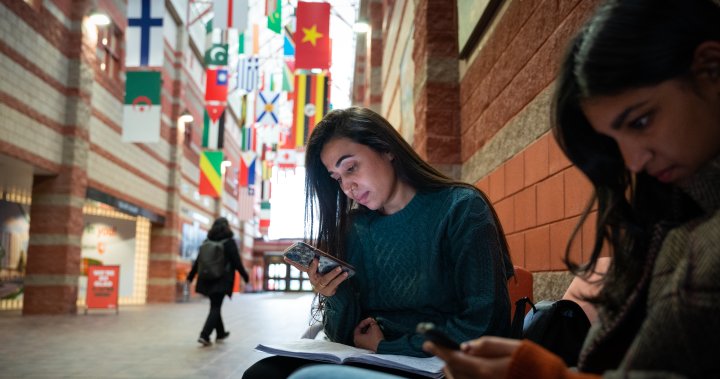The federal government’s cap on the intake of international students has drawn sharp reactions from learning institutions across the country, with concerns it will impose major financial challenges on colleges and universities and the services they offer.
On Monday, Immigration Minister Marc Miller announced a two-year national cap on the intake of international students into the country. He unveiled a slew of other curbs while speaking at the Liberal cabinet retreat, which he said would reduce the intake by 35 per cent over the next two years.
Miller said for 2024, the cap is expected to result in approximately 364,000 approved study permits – a decrease of 35 per cent from 2023.
Isaac Garcia-Sitton, executive director of international student enrolment, education and inclusion at Toronto Metropolitan University, told Global News the cap is bad news for universities.
“This cap will bring financial risks for institutions, which may translate into layoffs, program closures and fewer services for students,” he said.
Garcia-Sitton added that Ontario, in particular, is looking at a bleak forecast for learning institutions.
“In Ontario, the situation is compounded by the fact that at least 10 universities are projected to run deficits this year, a result of the provincial tuition freeze and decreased funding from operating grants.”
Around 800,000 international students currently call Canada home, with thousands more expected to come with every new academic year. According to Statistics Canada, the gulf between domestic and international fees is significant.
In the 2022-23 academic year, the average domestic student in Canada paid $6,834 in tuition. By contrast, the average international student paid nearly six times that amount at $36,123.
Garcia-Sitton said the gap can be attributed to the steady decline in funding of post-secondary institutions across Canada since the 1970s.
“With the stagnation of domestic tuition fees and declining public funding per student across several provinces, designated learning institutions in Canada have turned to the growing pool of international students,” he said.
Colleges and universities in Canada cannot raise tuition without the approval of the provincial government. British Columbia has already said students in public universities will not see an increase in tuition after the cap on international students.
Garcia-Sitton said this leads to a reliance on revenue from international student tuition.
“For instance, in the college sector in Ontario, international students from India not only contribute double the financial amount to the college system compared to Canadian students, but their contributions also exceed those made by the operating grants from the Ontario provincial government,” he said.
Get the latest National news.
Sent to your email, every day.
A 2020 Global Affairs Canada report said international students in Canada spend $22.3 billion on tuition, accommodation and discretionary spending every year. This is in addition to international students being a major source of labour for Canada, which has faced a worker shortage in recent years.
While universities, too, rely on international student tuition, it is Canada’s colleges that have come to rely heavily on those revenues over the last decade.
What do financial statements tell us?
In 2017-18, Canadore College in North Bay, Ont., made $12.25 million in tuition revenue from domestic students and $41.3 million from international students. In 2022-23, domestic tuition revenue rose to $14.5 million and international tuition skyrocketed to $131.5 million.
Sheridan College, which has campuses across Ontario in Brampton, Mississauga and Oakville, has seen domestic tuition revenue decrease in recent years. Between the academic years 2021-22 and 2022-23, Sheridan’s revenue from domestic students dropped eight per cent, from $65.2 million to $57 million, according to financial statements. Meanwhile, revenue from international students shot up 37.4 per cent, from $105.3 million to $142.7 million that year.
Seneca Polytechnic, based in Toronto, draws 80 per cent of its tuition revenue from international tuition and 20 per cent from domestic students, according to a spokesperson.
Migrant Students United is the student wing of the Migrant Workers Alliance for Change (MWAC). Sarom Rho, an organizer with MWAC, told Global News that “what’s happening is that international students are being punished. And that’s simply not fair.”
Reactions from learning institutions
Universities Canada, an advocacy group for Canadian universities, expressed concern over the cap.
“We are concerned that the cap per province is going to add stress on an already stressed system and until more information is provided as to how each province will be rolling out this new program, it is difficult to comment on its effect on Canada’s universities,” the group said in a statement on Monday.
It said the new process could mean prospective students choose other countries, aside from Canada, to pursue higher education.
“We anticipate the need for letters of attestation from each province could significantly affect processing times which could lead to students choosing to pursue post-secondary study in other countries,” the statement said.
Garcia-Sitton echoed this sentiment.
“This would not just affect Canada’s reputation as a destination for international education, but also have long-term implications for its economic, immigration and international education objectives,” he said.
University of Toronto vice-president Joseph Wong said the cap was not intended to “adversely impact universities such as ours.”
“The University of Toronto looks forward to working with all levels of government to ensure that the allocation of permits recognizes institutions like U of T (which uphold rigorous and transparent recruitment and admissions processes, and offer robust student supports) and addresses the problem where the challenges lie,” he said in a statement.
The Association of Atlantic Universities said the move to temporarily cap international admissions will negatively impact the region.
Peter Halpin, executive director of the association, said international students represent about 30 per cent of the enrolment at the 16 universities in Atlantic Canada, compared to about 20 per cent across the country.

Garcia-Sitton said universities and colleges will need provincial support in the days to come.
“Being a publicly funded sector, the foremost action the provincial government can take is to ensure adequate funding, as not having sufficient financial resources seriously compromises institutions’ ability to offer quality programming and support services for the students they enrol,” he said.
Rho said she hopes the cap will spark a bigger conversation about how Canada’s educational institutions are funded.




